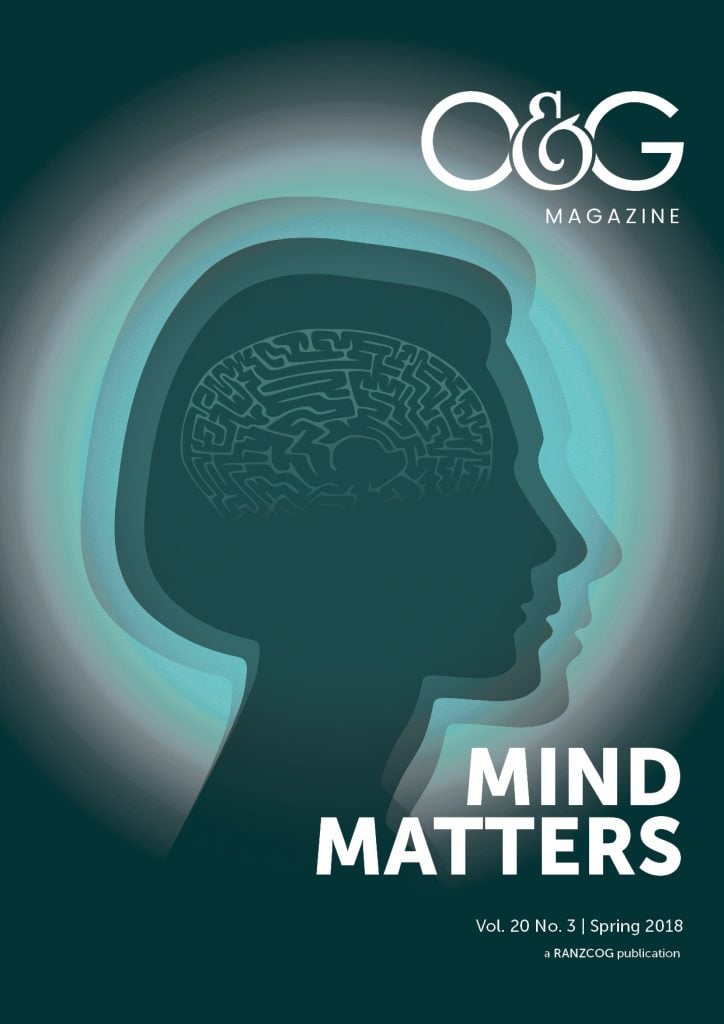Being an O&G specialist is rewarding, but it takes hard work, determination and sacrifice. The hours are long, while coping with the demands of a busy profession. Developing skills and building knowledge, as well as balancing family and personal commitments, can be challenging.1 Medical practitioners have higher levels of depression than the general population.2 They also experience significantly greater levels of psychological distress and thoughts of suicide than that of the general population. Younger doctors and female doctors are at particular risk.
The problem of poor mental health in the medical profession comes at great cost. In 2017, the media reported on the suicide of four doctors in five months in NSW.3 The State coroner went on to declare that his records show 20 doctors killed themselves between 2007 and 2016. In the first published study of suicide by health professionals in Australia, female doctors were reported as killing themselves at a greater rate than women in other employed populations (6.4 versus 2.8 per 100,000).4 Statistics from 2017 show that 83 per cent of RANZCOG Fellowship trainees are female, a potential ‘sex-related stressor’5 for current trainees.
In addition to personal factors and the demands of clinical practice, including adverse events, trainees may be left feeling unsupported by their professional organisations.6 People in high-risk jobs who are exposed to tragedy can benefit from readily available training and resources, to assist them in processing and recovering from the trauma they regularly deal with. It has been suggested that there should be systematic mental health checks on staff exposed to such trauma and that mental health breaks should be scheduled and encouraged, to ensure all staff perform at an optimum standard.7
A possible exacerbating factor is the resistance of medical practitioners to seek assistance for their own mental health concerns. There are many reasons for a culture of silence among medical practitioners, coupled with the general stigma of compromised mental health. Doctors are concerned that their career development could be in jeopardy, or that their professional integrity could be compromised. More concerning is the fear that doctors will have their registration to practise medicine cancelled.8
Warning signs of mental health changes
Warning signs of potential mental health changes in yourself or others include the following:
- Extreme tiredness
- Absenteeism or presenteeism
- Withdrawal or self-neglect
- Acute stress reactions
- Eating disorders or drug or alcohol dependence.
Early intervention and not being afraid to tell a colleague you are worried about them is the best approach to avoiding escalation of these warning signs.9
What can you do to further promote your health and wellbeing and that of your colleagues?
- Become self-aware. What are your particular stressors? How do you know when you are too stressed or have reached your threshold? While doctors can perform during periods of high anxiety or stress,10 it is important to develop awareness of when you are becoming overwhelmed.
- Meet regularly with peers and encourage open discussion about the difficulties you are experiencing.
- Access supervisor support, as it promotes collegiality and can protect against burnout.11
- For yourself, accept that at times, a period of leave is necessary or a reduction in hours could be discussed and mutually agreed upon within your workplace.
- Refer yourself to a GP who promotes the importance of doctor wellbeing. Such GPs can be found through the Doctors’ Health Advisory Service website and helplines in each state or region.
- Consider activities, such as mindfulness, to reduce the risk of emotional exhaustion and burnout.12
RANZCOG’s response
Medical colleges, among other stakeholders, have been urged to examine their practices and take an interest in the health of the whole medical workforce. RANZCOG has responded with the formation of the Training Support Unit (TSU). The TSU demonstrates a systematic approach and has put in place well-defined programs and pathways of response for a trainee or supervisor in need.13 A Trainee Liaison and Training Supervisor Liaison, with backgrounds in mental health, counselling, medical education and clinical practice, have been employed to assist and support RANZCOG members. The TSU encourages trainees, consultants and training supervisors to get in touch at times of difficulty.
The TSU has also put in place an external assistance program, Converge International. This program is available to all trainees and supervisors and can be accessed up to three times. The service can be contacted 24 hours a day, seven days a week and tailored to meet the needs of the individual.
Medical registration authorities
A concern of many doctors in dealing with personal mental health issues, and that of their colleagues, is the potential response by medical registration boards. Doctors fear that seeking help, or the mandatory reporting of colleagues, may place restrictions on their practice.
Organisations, such as the Australian Medical Association (AMA), the New Zealand Medical Association (NZMA) and a host of professional indemnity insurers, can be consulted and provide doctor-focused support services and education for members.
In Australia, doctors can call the Australian Health Practitioner Regulation Agency (AHPRA) for confidential advice if they have concerns or queries about voluntary or mandatory reporting. AHPRA has provided some information on reporting:
- The Medical Board of Australia receives around 3500 notifications each year.
- The fact that a notification is made does not mean that action will follow.
- Most notifications (around 80 per cent) will result in no regulatory action being taken.
- More than half of the notifications received are closed at assessment, the first stage in the process under which all notifications are considered by a group of medical practitioners and community members to decide if further information is required. The average length of time to assess notifications about medical practitioners in 2017–18 was 49 days. This process is getting faster each year.
RANZCOG’s submission to the Australian Health Ministers’ Advisory Council in 2017 is that, while all practitioners and employers remain under a mandatory obligation to report impairment and other forms of notifiable conduct, practitioners treating said doctors would have a complete exemption from the statutory requirement to report. If this recommendation is adopted, it will be another step in the right direction for doctors who need help.
Summary
Doctors are inherently caregivers and yet they find it increasingly difficult to care for themselves. RANZCOG has acted in response to the mounting evidence of poor mental health and wellbeing in the medical profession, by forming the TSU as a means of providing support to trainees and supervisors. This is one aspect of a safety net that includes employers, insurers and a range of easily accessible resources.
References
- Beyondblue. National Mental Health Survey of Doctors and Medical Students. Final Report. 2013 Oct;1-156.
- Bailey E, Robinson J, McGorry P. Depression and suicide among medical practitioners in Australia. Internal Medicine Journal 2018 Mar;48(3):254-258.
- Buttigieg M. Fourth young NSW doctor’s suicide exposes medicine’s ‘shameful secret’. Yahoo 7 News. 2017 Mar 18;cited 2018 Jul 08. Available from: https://au.news.yahoo.com/fourth-young-nsw-doctors-suicide-exposes-medicine-s-shameful-secret-34695413.html.
- Milner A, Maheen H, Bismark M, Spittal M. Suicide by health professionals: a retrospective mortality study in Australia,
2001-2012. MJA 2016 Sep 19;205(6):260-265. - Statistical Snapshot 2017. Melbourne (AUST): RANZCOG 2018. [Updated 2017; cited 2018 Jul 12]; [2 screens]. Available from: www.ranzcog.edu.au/about.
- Varughese E, Janda M, Obermair A. Can the use of quality assurance tools reduce the impact of surgical complications on the well-being of obstetricians and gynaecologists in Australia and New Zealand? ANZJOG 2014;54:30-35.
- Reynolds E. Dry retching every Monday: Australia’s most traumatic jobs. News.com.au. 2017 Nov 23. Available from: www.news.com.au/finance/work/at-work/dry-retching-every-monday-australias-most-traumatic-jobs/news-story/77c131d81881accd4d26e8d3d432b62e.
- Connelly E. Breaking the culture of mental health stigma: the challenges physicians face when seeking help. Medicalbag.com. 2018 May 2. Available from: www.medicalbag.com/lifestyle/physician-mental-health-stigma-challenges/article/762882/.
- A guide to supporting trainees in difficulty. Melbourne (AUST): RANZCOG 2018. Available from: www.ranzcog.edu.au/Training/Specialist-Training/Support-Resources.
- Dendle C, Baulch J, Pellicano R, et al. Medical student psychological distress and academic performance. Medical Teacher 2018 Jan;21:1-7.
- Baigent M, Baigent R. Burnout in the medical profession: not a rite of passage. MJA 2018 Jun;208(11):471-472.el.
- Lebares C, Guvva E, Ascher N, et al. Burnout and stress among US surgery residents: psychological distress and resilience. J Am Coll Surg. 2017 Jan;226(1):80-90.
- Riley G. Understanding the stresses and strains of being a doctor. MJA 2014 Oct 4;181(7):350-353.







Leave a Reply